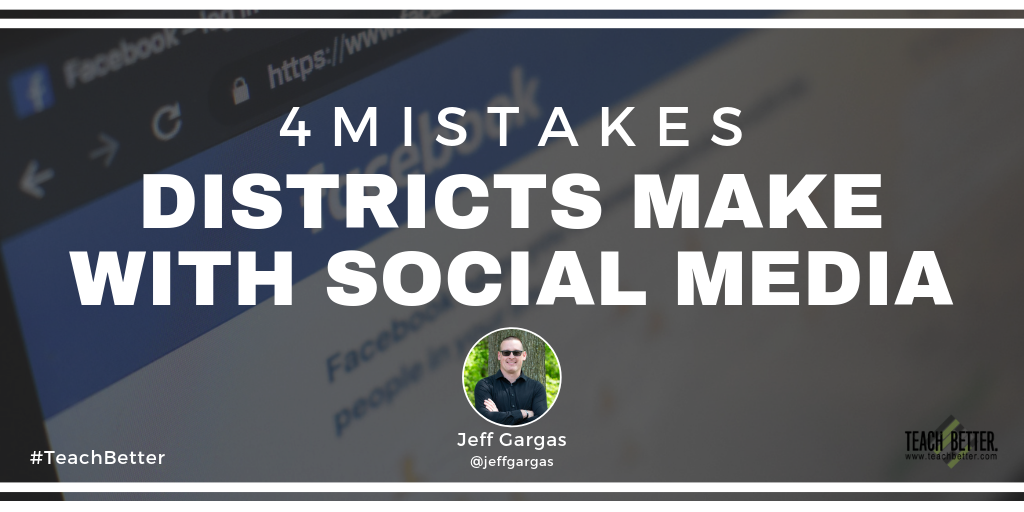In This Post:
- Being on social media should be a must for any school district. Avoiding these common mistakes should be, too.
- Using a specific hashtag for your district creates an easy-to-follow story on social media.
- Trying to be on too many platforms, and not staying consistent, can hurt your growth and the effectiveness of your social media efforts.
- Regardless of whether you’re just getting started, or your district has been on social media for a while, avoiding these 4 common mistakes will help utilize your profiles to engage and communicate with your audience.
The case for why your district should be on social media is a strong one. The majority of all people are on social media, so like any good brand, your district should also be there, to engage and communicate with your audience. A while back, I shared how your district can get started, so I’m just going to assume you’re now either using social media, or preparing to launch your social strategy. Unfortunately, getting started, while a crucial step, is just the first step. The next step is to make sure you’re avoiding some of the most common mistakes school districts make with social media.
So let’s take a look at the 5 most common mistakes we’ve seen.
1. Not Using A School/District Hashtag
Let’s start with the basics: The function of a hashtag (#) is to make it easy for people to find posts, tweets, and profiles/pages that are connected to a common theme or topic. For an example, if you search #TeachBetter on Twitter, Facebook, or Instagram, you’ll find the results include posts, tweets, and people who are sharing information and interacting around the Teach Better Mindset.
So, in the same way a hashtag makes it easy for people to find others interested in a topic, a hashtag for your district allows people to find posts and people connected to, or talking about, your district.
Your hashtag not only invites people to be a part of your district’s story, but it also make it easy for them to follow that story.
I strongly suggest researching potential hashtags to make sure it is not already in use. You can use a tool like www.tagboard.com to see if a hashtag is already in use. You can also just search Twitter, Facebook, and Instagram to see what results come up.
Once you’ve established your hashtag, make sure it is used in all your posts, across all social media platforms. Encourage your staff, students, and community to use the hashtag so they can contribute to your story.
Need an example?
#GoCrickets is used by the Fall Creek School District, lead by our good friend, Joe Sanfelippo.
So I challenge you to take a moment, chat with your team, and create your own, unique hashtag. Then, tweet @jeffgargas and let . me know what it is.
2. Trying to Be On All Platforms at Once
This is a mistake that happens across all industries. Businesses stumble on social media all the time, simply by trying to be too many places at once. When you try to be on all platforms at once, you run a serious risk of not paying enough attention to any single space.
Now, if you have a dedicated social media team, you can probably pull off being on multiple social channels at once. But let’s be real here, most school districts do not have a team dedicated to social media. Most likely, you have one person, or a small group of teachers, handling the primary responsibilities. But that person (or people) is also responsible for a classroom full of students, or tech integration, or a whole list of other tasks that require a massive amount of time and energy.
Because of this, it is important to figure out the best platform to start with. Talk with your audience, whether it be students, stakeholders, your community, or a combination, and figure out the platform that is most likely to reach the largest . percentage of that audience, and start there. In a lot of cases, this is going to be Facebook, but depending on what your goals are, it might be Twitter, or Instagram.
The point is, starting with one is a good idea. Get your systems in place and build that one profile, then move on to the others.
[scroll down to keep reading]3. Not Being Consistent
Often times, the above mistake leads to this one. When school districts attempt to grow too many social profiles at once, it tends to lead to a lack of consistency in posting and engaging with their audience.
A profile with thousands and thousands of followers who never get any new information or updates, isn’t all that useful. When people connect with your profiles (via a like or a follow) they’re signaling that they are interested in what you have to say and interacting with you, so it’s important to actually say things, share things, and interact.
This goes back to starting with one platform. Get your systems in place to focus on pushing out content, whether that be important updates, resources, or entertaining content, and then make sure you’ve got a schedule laid out for when you’ll be posting/tweeting. After that, focus on engagement; following others, liking their content, reacting to engagement on your content, etc.
Consistency shows people that your profile/page is a good resource for information, for whatever it is that got them there in the first place. Staying consistent will encourage them to check back more often, and pay attention to what you put out there.
4. Social Media Links Not On Site
This is a pretty basic, but very important one. Your website is the “hub” of everything these days. It is where people go to find information on how to contact you, how to enroll their students, the yearly calendar, athletic calendars, and even check their child’s grades and progress.
So, if your audience goes to your website for pretty much any information they need on your district, doesn’t it just make sense to have your social media profiles linked from that site? Yea…I thought you would agree.
It’s simple really, make sure your social media profiles are linked to from your website. I highly recommend making them easy to fine, toward the top of the site. This way, visitors to the site know that you are also on social media, and connect with you there, building your presence on those platforms.
Quick tip: When linking your social accounts from your website, make sure the link opens in a new window. This way, they will be connected to your social profile, but it won’t take them off of your website. This allows someone to check you out on social, but keeps them in the place they were originally looking for information, connecting them with you in two ways.
Whether you’ve launched a massive social media campaign for your school district, or you’re just starting to test the waters, these are 4 common mistakes that are easy to avoid. As you layout your plan, or adjust one already in place, consider creating a district hashtag, make sure you’re staying consistent (made easier when focusing one fewer social channels), and be sure your social profiles are linked from your website. These are seemingly small and simple steps to take, but we’ve seen them make a world of a difference.
Be sure to tweet @jeffgargas and share your school district’s hashtag withe me. Go ahead and include #TeachBetter in there so others can see your awesomeness as well!
About Jeff Gargas
Jeff Gargas is the COO and co-founder of the Teach Better Team. Prior to co-founding Teach Better Team, Jeff was the owner of ENI Multimedia, an online marketing firm, where he worked with entrepreneurs and small businesses, assisting them with web design, social media, content marketing, and brand awareness.
Prior to all of this, Jeff was an adjunctive professor at Kent State University and spent 10+ years in the music industry. He has spoken at conferences around the country, and has successfully promoted more than 500 events and launched 7 businesses in a variety of industries.
Jeff is passionate about music, and enjoys spending time with his family as often as possible.
Top header image photo by Con Karampelas on Unsplash.




